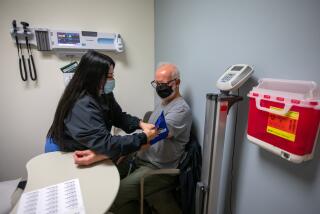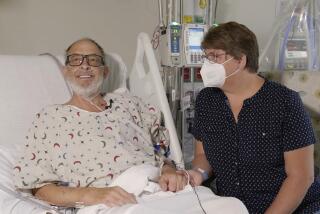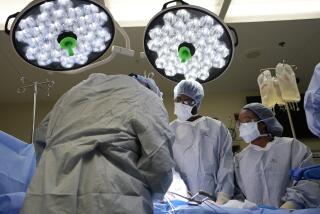With All Their Hearts, They Support Transplants : Both the doctors and the patients at Hoag are enthusiastic about the life-saving procedure that has gone from experimental surgery to standard--and very successful--treatment.
“He’s alive!”
Morris Kessler always remembered that line from the 1931 movie “Frankenstein,” exclaimed by the doctor as his monstrous patchwork creation began to move.
Last September when he woke up from surgery with a new heart sewn into his chest, Kessler imagined his own doctors speaking those words, but with a difference: “I would like to believe my doctors said, ‘He’s alive . . . and doing well,’ ” Kessler says. “That’s why the monster turned out the way he did, because he was only alive. But I’m alive and I have my normal life back.”
Kessler, 65, of Los Alamitos, and his doctor, Douglas Zusman, co-director of cardiac surgery at Hoag Hospital in Newport Beach, spoke last week to the Associates of Hoag Heart Institute as second in a series of heart-related educational programs scheduled for this year.
Since the first such operation was performed nearly 24 years ago, heart transplantation has evolved from a controversial experimental technique to standard procedure for patients whose heart problems are too severe to respond to any other treatment, Zusman says. More than 250 centers nationwide are performing heart transplants, including the Hoag center, where its first transplant was performed nearly three years ago.
“We’ve done 19 transplants since then. Some have died a year or so afterward, but our survival rate overall is 93%,” Zusman says. Nationally, he says, the one-year survival rate is about 80%, with about 65% of patients still alive after five years.
Both surgical techniques and post-surgical management, including immunosuppression drugs, have now been fine-tuned to the point that further advances must come on another front. “The only thing holding us back now is the limited number of donor organs,” Zusman says.
Only 20% to 25% of brain-dead trauma victims and others who could become organ donors actually do so, according to Barbara Eklund, cardiac transplant coordinator at Hoag. This is largely because so many people neglect to sign and carry organ donor cards.
On April 19, to commemorate National Organ Donor Awareness Week, Hoag will host its Fourth Annual Organ Transplantation Symposium.
At any given time, about 1,700 people across the country are waiting for donated hearts. Most will die within six months of diagnosis if a new organ is not found for them. In Orange County, there are now five patients on the waiting list.
Before the Hoag center was set up, Orange County heart patients had to travel to Los Angeles or Stanford University in Palo Alto for transplant surgeries. But Zusman, who worked at Stanford with transplant pioneer Dr. Norman Shumway, says the proliferation of local transplant centers in major population centers such as Orange County has helped because long-term management can be handled locally.
“The operation itself is the easy part,” he says. “It’s what happens afterward that can be tricky.”
Heart transplant patients can go on to enjoy active, healthy lives, Zusman says. “One of our patients at Stanford was from Kansas City, and he rode his bicycle all the way one year for his checkup.”
Dr. Norton Humphreys, 61, of Fountain Valley, the first Hoag transplant recipient in April, 1988, says he had visions of becoming a marathon runner after his surgery.
“Being the first, I didn’t have anybody to talk to that had been there before, so my expectations were a little unrealistic. I thought of it as something like putting a new engine in an old Chevy and figured I’d really have a lot of power afterward. Well, the new engine is great, but the old Chevy just isn’t up to it.
“Part of the problem is that I spent eight years between my diagnosis of cardiomyopathy and my transplant, so by the time I got my new heart, the rest of me was very deteriorated,” he says.
Humphreys, who admits he “wasn’t much of a jock” before he developed heart disease, now settles for three long aerobic walks each week and a little light weightlifting.
That might not seem like much, but contrasted with his pre-transplant condition, it might as well be marathon running.
“I was down to the point where I was so limited physically I couldn’t brush all my teeth at one time without getting short of breath. I couldn’t shave my entire face without resting.”
Humphreys says he doesn’t consider his life to be “back to normal,” but “you get to the point where life is definitely worth living. While you’re sitting around waiting for a new heart, you wonder if it is.”
Although his heart is doing well, he now has to deal with another health problem: “I’m legally blind. Nobody really knows whether it’s connected. I can’t read, can’t drive, but I can see well enough to take my walks. I just have to be extra careful about looking both ways.”
Unlike Humphreys, Kessler lived an active life with plenty of exercise until a decade ago when he experienced his first heart attack. “I was very athletic, always good shape, never smoked, never drank, watched my weight, and my wife prepared balanced meals,” he says.
Despite a coronary angioplasty and a sextuple-bypass operation, he suffered further heart problems and was forced to retire from his job as a general sales manager just before his 56th birthday. His condition deteriorated after that, and then on Valentine’s Day, 1990, he suffered another severe heart attack that left him with a seriously damaged left ventricle, the heart’s largest pumping chamber.
By August, when he had another heart attack, his doctors decided a transplant was his only hope. Fourteen days after he was placed on the list--an unusually short waiting period--Kessler was told a new heart had been found. The donor was a 17-year-old San Diego girl who had died of brain seizures. Last month, he wrote a letter to the girl’s parents--forwarded through the Hoag transplant center--to thank them for making the donation. Kessler does not want to know their names.
“It took beautiful persons like you that were aware of the much-needed donor program that really makes the difference in the lives of organ transplantees,” he wrote.
Now that he has made it through the first crucial months, Kessler has begun a fitness program. “I started by walking around the block, then by going shopping, waxing floors, vacuuming, doing things around the house. Now I do a lot of walking. And in two weeks, I will be taking up golf again and become more active. I can’t wait.”
Organ donor cards are available from the Department of Motor Vehicles or from the hospital. Call (714) 645-8600, extension 2095, for more information. To learn more about the Associates of the Hoag Heart Institute, call (714) 760-5953.






